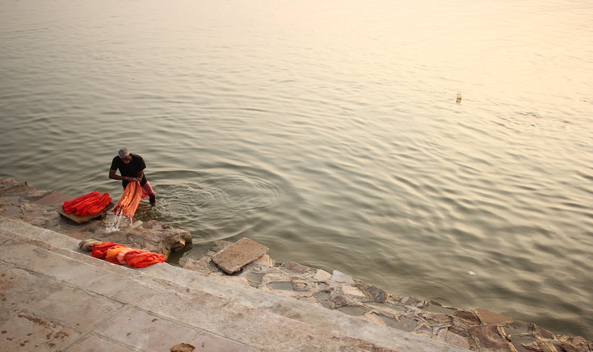The Ganges-Brahmaputra-Meghna basin is a birthplace of flourishing cultures and livelihoods with a total area of 1.7 million square kms. The basin is distributed across Nepal, India, Bangladesh, China and Bhutan and finally joins the Bay of Bengal. Apart from being the third largest freshwater outlet to the world’s oceans, the basin supports more than 800 million people. In South Asia the Ganges river is located in India, Nepal and Bangladesh, the Brahmaputra river is located in India, Bangladesh and Bhutan, and the Meghna river basin is located in India and Bangladesh.
Many societies, cultures and economies depend on the basin for various needs, but the ecosystem services provided by the basin are also exposed to severe risks. According to the World Bank Bangladesh Development Series the GBM basin will undergo a projected temperature rise of 1-3°C and 20 percent
more monsoon rainfall by 2050. Intensification of climate events, degradation of ecosystems, unregulated infrastructure development and unplanned land use practices have caused increasing stress on water resource and limited accessibility for the communities. The increasing climate risk also leads to issues of gender disparity and social inequalities in addition to water accessibility challenges. Climate change poses threat of crop damage, loss of life and property and increase of climate related disasters. Communities of the basin feel vulnerable due to climate risks and rapidly changing socio-economic scenario.
According to the World Bank by 2030, South Asia’s water demand will double due to unsustainable usage impacting lives, and livelihoods. About 20 percent of the population in the GBM basin lacks access to safe drinking water. Additionally, the Water Development Report 2016 highlights, globally 78% of the jobs are water dependent and increasing stress on water resources can lead to direct impacts on the water dependent sectors. At the face of changing climatic and socio-economic conditions the demand of water also increases for industries and communities.
Multilateral cooperation and good governance for upstream and downstream linkages of the countries of the basin will improve water accessibility and build resilience to climate change of riparian communities.
The GBM basin have social, biophysical, cultural, economic and institutional interdependence which sustains agriculture, economic activities and societal functions of the basin. Multidimensional and inclusive governance and cooperation by the basin countries will ensure equal accessibility of resources.
Baseline of women and youth issues vis-à-vis water governance
Women and youth leadership forms the bedrock of improved cooperation in governing shared water resources and strengthening resilience to climate change.
According to the UN, 4.8 to 5.7 billion people suffer from water scarcity at least 1 month a year affecting women the worst. Around 80% of the household in low- and middle-income countries women are the main water collectors and depend on the river for various domestic, agricultural and other livelihood purposes. While the gender roles pose challenges to water accessibility gender mainstreaming in policies can combat climate change. Although in 2013, only 15% of the countries had a gender policy in their water ministry and 33% of countries has included gender considerations in their water-related policies and programmes but women’s cooperation, participation and leadership in decision making and water dialogues in local and national level will ensure improvement of the river’s ecosystem and health. The Involvement of women in water governance makes a programme 7 times effective.
Along with gender considerations youth’s involvement will accelerate water related climate action.
The UN Water SDG report states the youth are hardest hit by the water crisis. Due to severities posed by extreme climate events the youth migrates to urban areas seeking better opportunities. Youth can also help carry forward traditional and indigenous knowledge and introduce scientific methods to the communities. Youth’s participation and community involvement will result in reducing risks of the riparian community.
Inclusive participation will not only help restore the environment but also achieve the sustainable development goals.
About Transboundary Rivers of South Asia (TROSA- 2) Rivers, Rights and Resilience
The Transboundary Rivers of South Asia (TROSA-2) is a regional governance programme covering the Ganges-Brahmaputra-Meghna basin in India, Nepal and Bangladesh. The goal of the program is to Improve cooperation in governing shared water resources, strengthening resilience to climate change of riparian communities in the transboundary Ganges-Brahmaputra-Meghna River basins.
The Asian Disaster Preparedness Center is a partner organization with Oxfam, funded by the Swedish International development Co-operation Agency (SIDA).
The expected outcomes of the programme are:
Strengthen leadership of civil society, especially women, indigenous people, and youth to influence government and private sector on water governance across and between the transboundary GBM basins.
Strengthen cooperation, collaboration and accountability across and between the transboundary GBM basins.
What is happening to the transboundary rivers of South Asia?
Climate change is limiting water accessibility from the Ganges-Brahmaputra and Meghna Basin. Communities particularly feel vulnerable as they depend on the river for various purposes. Strengthened community leadership and climate finance tools can help fight resilience and improve water governance.
WOMEN LEADERS
& YOUTH LEADERS
AWARDS
Asian Disaster Preparedness Center is recognizing women and youth for their exceptional contribution in the sphere of water governance and building climate resilience
Women Leaders Award: Three Women Leaders who have worked in the River Basins of India, Bangladesh, Nepal will be selected
Youth Leaders Award: Three Youth Leaders who have worked in the River Basins of India, Bangladesh, Nepal will be selected
For women leaders: Nominate and fill in application form (Click Here)
For youth leaders: Nominate and fill in application form (Click Here)
Last date for entries: Deadline Extended till the end of October, 2024
Inspiring Women and Youth Leaders
Asian Disaster Preparedness Center (ADPC) recognizes women leaders and youth leaders’ contribution to effective and inclusive water governance and strengthening climate resilience in order to ensure sustainable outcomes. Women’s leadership and Youth leadership in water dialogues and their cooperation in community-level decision-making will contribute to improvement of the river’s ecosystem and health.
Improved water accessibility for India, Nepal and Bangladesh can be well achieved by promoting women and youth leadership for better transboundary cooperation. Women and youth leadership potential can lead to transformational impacts and mitigate effects of climate-related disasters like floods and droughts.
Eligibility Criteria
-
The candidate can nominate themselves or can be nominated by their organization or by an individual.
-
This opportunity is open to women and youth leaders from both local and national levels who have experience working in one or more river basins such as the Ganges, Brahmaputra, Meghna, and other river basins in India, Bangladesh, and Nepal.
-
For women leader nominees: Nominee must be above 18 years of age.
-
For youth leader nominees: Nominee must be between 18 and 35 years of age.
-
Legal organizations including, but not limited to, IGOs, CBOs, local government, private sectors and academic institutions are eligible to nominate.
-
Nominated candidate must fill in the application form: Only successfully submitted and completed application forms will be processed for selection. Organizations and individuls can also fill out the application form on behalf of applicants.
-
Entries open to all nationals who have worked in the river basins of India, Nepal and Bangladesh.



